650 g/ha.
The sterilized cocopeat @ 720 kg / ha is mixed with 10 kg of neem cake and
Azospirillum and Phosphobacteria each @ 1kg. About 1.25 kg of the cocopeat medium is required for each tray.
Hills : 40 x 40 cm
Plains : 45 x 30 cm
Provide continuous supply of moisture
Hills
60x 45 x 45 cm in paired row system
Recommended Dose: 200:125:150 kg/ha
| Stage | Crop stage | Duration in days | Fertilizer grade | Total fertilizer (kg/ha) | Nutrient supplied | % requirement | ||||
| N | P | K | N | P | K | |||||
| 1 | Transplanting to plant establishment | 10 | 19:19:19 + MN 13-0-45 Urea | 32.87 19.42 24.36 | 6.25 2.52 11.21 | 6.25 – – | 6.25 8.74 – | 10.00 | 5.00 | 10.00 |
| Subtotal | 19.98 | 6.25 | 14.99 | |||||||
| 2 | Head initiation stage | 30 | 12-61-0 13-0-45 Urea | 20.37 133.20 130.74 | 2.44 17.32 60.14 | 12.50 – – | – 59.94 – | 30.00 | 10.00 | 30.00 |
| Subtotal | 79.90 | 12.50 | 59.54 | |||||||
| 3 | Head initiation to development stage | 30 | 19:19:19+ MN 13-0.45 Urea | 32.87 86.02 92.37 | 6.25 11.18 42.49 | 6.25 – – | 6.25 38.71 – | 20.00 | 5.00 | 20.00 |
| Subtotal | 59.92 | 6.25 | 44.96 | |||||||
| 4 | Harvesting stage | 35 | 12-61-0 13-0-45 Urea | 10.18 66.60 65.38 | 1.22 8.66 30.07 | 6.25 – – | – 29.97 – | 40.00 | 5.00 | 40.00 |
| Total duration | 105 | Subtotal | 39.95 | 6.25 | 29.97 | |||||
| Total | 199.75 (or) 200.00 | 31.25 | 149.85 (or) 150.00 | 100 | 25 | 100 | ||||
1.Diamond back moth: Plutella xylostella

Symptoms of damage:
|
Management:
2.Cabbage borer: Hellula undalis
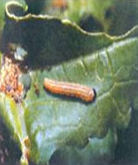
Symptoms of damage:
|
Management:
3.Leaf webber: Crocidolomia binotalis
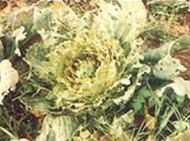
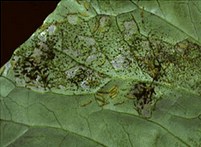
Symptoms of damage:
|
Management:
4.Cabbage green semilooper : Trichoplusia ni
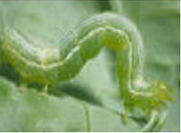
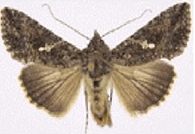
Symptoms of damage:
|
Management:
5.Cabbage butterfly: Pieris brassicae, P.rapae


Symptoms of damage:
Management:
6.Tobacco caterpillar: Spodoptera litura

Symptoms of damage:
|
Management:
7.Cabbage aphid: Brevicoryne brassicae
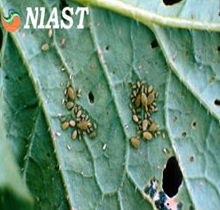
Symptoms of damage:
|
Management:
8.Mustard aphid: Lipaphis erysimi

Symptoms of damage:
|
Management:
1.Nitrogen
|
| Deficiency Symptoms |
Yellowing of old leaves; stunted plant growth |
| Correction Measure |
Foliar spray of urea@1% |
2.Phosphorus
|
| Deficiency Symptoms |
Pigmentation in old leaves; curd size and quality will be affected |
| Correction Measure |
Soil application of recommended dose phosphorus |
3.Potassium
|
| Deficiency Symptoms |
|
| Correction Measure |
Foliar spray of K2SO4 1% twice at weekly intervals |
4.Calcium
|
| Deficiency Symptoms |
Leaf growth will be inhibited; scorching symptoms occur in new leaves |
| Correction Measure |
Foliar spray of CaCl2@1% |
5.Magnesium |
| Deficiency Symptoms |
Stunted plant growth; leaves become small; yellowing symptoms occur in old leaves |
| Correction Measure |
Foliar spray of MgSO4@0.5-1.0% |
6.Sulphur
|
| Deficiency Symptoms |
Youngest leaves turned purplish, cupped upward leaf edges rolled in. |
| Correction Measure |
Soil application of Gypsum 50 kg/ha |
7.Boron |
| Deficiency Symptoms |
Apical growing points stop developing leaves thick brittle and irregular chlorosis. |
| Correction Measure |
Foliar spray of Borax 0.5 % at fortnightly intervals |
8.Copper
|
| Deficiency Symptoms |
Symptoms occur in young leaves; leaf growth will be affected; curd size also affected |
| Correction Measure |
Folia spray of CuSO4@0.5% |
9. Iron
|
| Deficiency Symptoms |
Chlorosis occur in young leaves; leaves become smaller in size; stunted plant growth |
| Correction Measure |
Foliar spray of FeSO4@0.5% |
10. Manganese
|
| Deficiency Symptoms |
Symptoms seen in young leaves; occurence of chlorosis; leaves become pale yellow in color |
| Correction Measure |
Foliar spray of MnSO4@0.4% |
11.Molybdenum
|
| Deficiency Symptoms |
Stunted plant growth with malformed leaves |
| Correction Measure |
Foliar spray of sodium molybdate @ 10mg/litre |
12.Zinc
|
| Deficiency Symptoms |
Occurence of little leaf symptoms; curd size will be small; chlorosis occur in young leaves |
| Correction Measure |
Foliar spray of ZnSO4@0.5% |
1.Club root disease – Plasmodiophora brassicae
Symptoms
Management
2.Downy mildew: Peronospora parasitica
Symptoms
Management
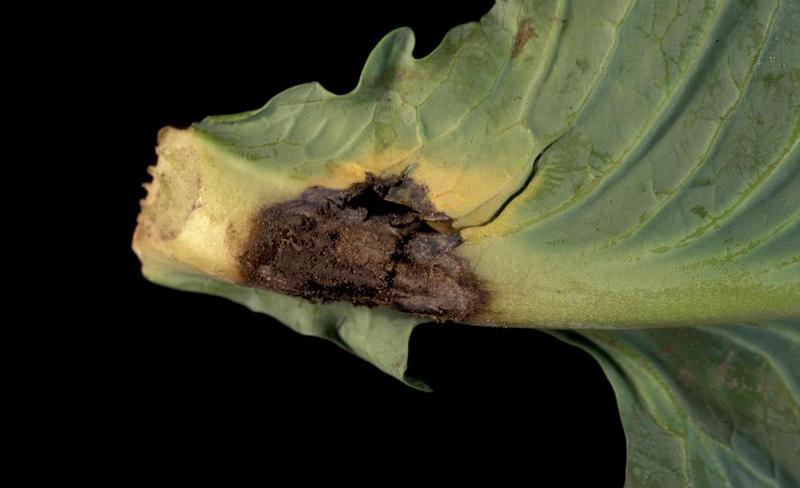
Symptoms
Management
4.Black spot: Alternaria sp.
Symptoms
Management
5.Black leg: Phoma lingam
Symptoms
Management
6.Powdery mildew: Erysiphe polygoni
Symptoms
Management
Symptoms
Management
Symptoms
Management
Hills: 70 – 80 t/ha in 150 days.
Plains: 25 – 35 t/ha in 120 days.
Crop Growing districts Nilgris, Krishnagiri, Theni, Erode
Major markets in Tamil Nadu Mettupalayam, Ottanchathiram, Hosur and Dindigul
Grade Specification Size and Weight
